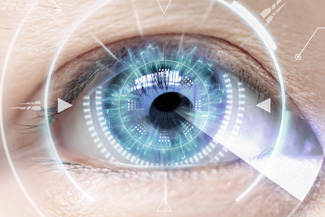WHAT IS KERATOCONUS?
We diagnose and treat keratoconus
Your cornea is the transparent, outer lens of your eye, and it typically has a smooth dome shape. Keratoconus describes a condition in which the corneal structure isn’t strong enough to maintain healthy ball shape. As a result, the cornea bulges outward into more of a cone. Our professional optometric team at our eye care clinic is knowledgeable about how to diagnose and treat keratoconus.
Keratoconus is rare, with an estimated one person out of every 2,000 having the condition. It generally appears in the teenage years and can progress slowly or rapidly. Keratoconus also runs in families, so if you or your children are at risk, it’s advised to contact us for a thorough eye exam.


Causes of Keratoconus
Your cornea is held in place by very small collagen fibers. When they are weakened and too fragile, they aren’t able to preserve the round shape of your cornea. A reduction in the protective antioxidants of your cornea, which act to destroy damaging by-products made naturally by corneal cells, is what causes keratoconus.
In addition to genetics, some types of eye injuries may increase your chance of being diagnosed with keratoconus. Specific ocular diseases, such as retinitis pigmentosa, vernal keratoconjunctivitis and retinopathy of prematurity, as well as some systemic conditions (Down syndrome, Ehlers-Danlos syndrome, Leber's congenital amaurosis and osteogenesis imperfecta) are also associated with this corneal abnormality.
Symptoms of Keratoconus
When the shape of your cornea begins to bulge, it alters your eyesight in two different ways. As the cone shape forms, your normally smooth corneal surface becomes wavy, called irregular astigmatism. Additionally, as your cornea expands, vision becomes increasingly nearsighted. Focusing becomes impossible without eyeglasses or contact lenses. Usually, the problems begin in one eye and develop later in the other eye too.
Altogether, these changes can create the following symptoms:
- Blurred vision
- Streaking of lights
- Halos around bright lights at night; glare
- Sudden change of vision in only one eye
- Objects appear distorted, both near and distant
- Double vision from just one eye
- Triple ghost images


How We Diagnose Keratoconus
Our eye doctors are contact lens specialists: we will inspect carefully for the signs of keratoconus during your comprehensive eye exam. It’s critical to inform us of any symptoms that you’ve been experiencing. To diagnose the condition, we’ll measure the shape of your cornea. Computerized Corneal Topography is used for this procedure, which takes a picture of your cornea and analyzes it instantly.
Treatment for Keratoconus
The first line of treatment is usually new prescription eyeglasses. If this solution doesn’t help you achieve good vision, then contact lenses will be tried. Rigid, gas permeable lenses are typically prescribed.
Severe keratoconus may lead to extreme scarring, due to overstretched collagen fibers. If the back of your corneas tears as a result, swelling may occur. It can take months for the swelling to go down, and a large scar is generally created. PTK, a specialized procedure, can smooth out this scar, thereby enhancing contact lens comfort.
Cornea collagen crosslinking is another therapy that has shown to be effective in slowing the progression of keratoconus. An alternate remedy is called intacs, which are semicircular implants inserted under the surface of the cornea to flatten the bulging cone shape and give better vision.
As a last resort, a cornea transplant may be performed. During this procedure, the center of your cornea will be removed and replaced with a donor cornea. The new cornea is stitched into place, and you’ll need to wear contact lenses for adequate vision after the surgery.


Dangers of LASIK and Keratoconus
LASIK can potentially weaken the cornea of anyone who suffers from keratoconus, making it a dangerous procedure. If this happens, your vision will become substantially worse. Even if your keratoconus is mild, LASIK is not an option.
